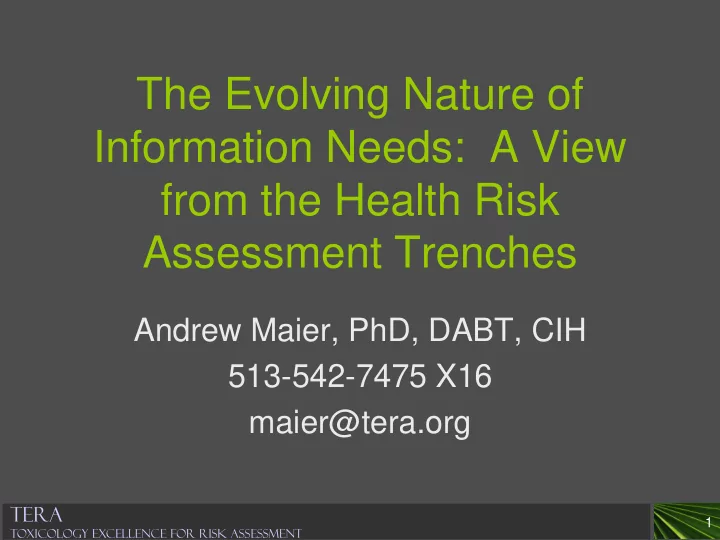

The Evolving Nature of Information Needs: A View from the Health Risk Assessment Trenches Andrew Maier, PhD, DABT, CIH 513-542-7475 X16 maier@tera.org TERA 1 TOXICOLOGY EXCELLENCE FOR RISK ASSESSMENT
Objectives of Talk • The paradigm used to make decisions in health risk assessment – What are the information needs? • Key drivers resulting in evolving nature of information needs – Why are the needs changing? • Areas for future risk data growth – What new information will be needed? TERA 2 TOXICOLOGY EXCELLENCE FOR RISK ASSESSMENT
Risk Assessment Paradigm NAS 4-Step Paradigm Hazard Assessment & Characterization Dose Response Assessment Exposure Assessment & Characterization & Characterization Risk Assessment & Characterization TERA 3 TOXICOLOGY EXCELLENCE FOR RISK ASSESSMENT
The Risk Value Process ABOVE SAFE DOSE FOG OF UNCERTAINTY "SAFE" REGION OF NO EFFECTS "NOT SAFE" REGION OF ADVERSE EFFECTS SAFE DOSE INCREASING DOSE This process incorporates the fundamental concepts of toxicology – that for non- cancer effects, there is an exposure threshold below which exposure is safe and the onset of toxicity is a function of the exposure concentration. TERA 4 TOXICOLOGY EXCELLENCE FOR RISK ASSESSMENT
Risk Value Derivation for Dose-Response Assessment Measure of Dose-Response Risk Value = Factors to Address Uncertainty in Extrapolation Nearly all groups - whether evaluating food, product, environmental, or occupational risk - use this basic concept for non-cancer dose-response assessments. However, the specific terminology differs among these groups. TERA 5 TOXICOLOGY EXCELLENCE FOR RISK ASSESSMENT
Risk Characterization Exposure Estimate Hazard Quotient = Safe Dose Estimate Nearly all groups - whether evaluating food, product, environmental, or occupational risk - use this basic concept for non-cancer dose-response assessments. However, the specific terminology differs among these groups. TERA 6 TOXICOLOGY EXCELLENCE FOR RISK ASSESSMENT
Drivers for Change • Science Drivers – Improved understanding of molecular toxicology – Improved computing resources – • Incorporation of biomathematics • Information sharing capacity increased • Regulatory Drivers – Output Needs to Increase • Collaboration and Harmonization initiatives – Methods need to improve • Focus on MOA Frameworks • Alternative to animal testing • Systems biology focus TERA TOXICOLOGY EXCELLENCE FOR RISK ASSESSMENT
Create the future - Collaborate • International Programme on Chemical Safety (IPCS): Harmonization Project • Methods Harmonization – Harmonization is not standardization – Understanding the methods and practices used by various organizations – Developing confidence in and acceptance of assessments using different approaches – Willingness to work toward a convergence of methodologies as long-term goal TERA TOXICOLOGY EXCELLENCE FOR RISK ASSESSMENT
Alliance for Risk Assessment ( ARA ) (www.allianceforrisk.org) Stakeholder Process ARA Process States, Fed. Agencies, Steering Public Interests, Committee Risk Document Industry Development Training and Initiation of Certification Risk Issue Non-profit Risk Collaborators Communication Document Draft Risk Research And Tools Peer Peer Review & Risk Information Reviews Consult Exchange (RiskIE) Release to Public
RiskIE Risk Information Exchange www.allianceforrisk.org/RiskIE.htm • An interactive Database to Communicate In-Progress Risk & Toxicity Assessments • Includes over 7000 projects being conducted by more than 27 organizations representing 13 countries • Available at the Alliance for Risk Assessment ( ARA ) website 10
ITER International Toxicity Estimates for Risk www.tera.org/ITER http://toxnet.nlm.nih.gov • Provides chronic human health risk values and cancer classifications from organizations around the world for over 650 chemicals • Includes a synopsis that explains the underlying basis and rationale for each risk value and differences in risk values • A link to each organization’s website or source document • A forum through which independent parties can share their peer reviewed risk values
NLM’s TOXNET 12 TERA TOXICOLOGY EXCELLENCE FOR RISK ASSESSMENT
Trends in Dose Response Assessment • Mode of action rather than endpoint-based assessment – harmonize cancer and non- cancer • Earlier assimilation of empirical dose- response data – use biomarkers • Development of frameworks to have risk assessors thinking in the context of data to replace default assumptions based on MOA TERA 13 TOXICOLOGY EXCELLENCE FOR RISK ASSESSMENT
TERA 14 TOXICOLOGY EXCELLENCE FOR RISK ASSESSMENT
A New Paradigm: Activation of Toxicity Pathways Exposure Tissue Dose Low Dose Higher Dose Higher yet Biologic Interaction Perturbation Normal Biologic Biologic Inputs Function Early Cellular Changes Adaptive Stress Morbidity Cell Responses Injury and Mortality
Effect of MOA Emphasis • Piles of new raw data – requiring libraries for data shared in a common format – E.g., NIEHS TOXCAST efforts • Tools for managing data inputs and outputs (predictions) from QSAR and other modeling • Increase need for “tool boxes” and decision support systems that integrate results across models – e.g., ECHA QSAR and Exposure modeling suites TERA 16 TOXICOLOGY EXCELLENCE FOR RISK ASSESSMENT
Evolving Data Needs • Individual Study Data – PubMed/Toxline • Compilations for a single substance – multiple studies – IRIS • Comparisons of content among integrated compilations – ITER • Application resources – CHEMM TERA 17 TOXICOLOGY EXCELLENCE FOR RISK ASSESSMENT
The 2010 “ Tricorder ” • One-stop shopping – Rich source of toxicology data, and – Rich source of methodology information, and – User algorithms (or at least exports to user tools) • Tools to identify the most relevant content • Need access to everything, but want most relevant first: relevance sorting, quality filters, value of information tools, decision logics • Compatibility with mobile technology • Do we have an App for that? TERA 18 TOXICOLOGY EXCELLENCE FOR RISK ASSESSMENT
Questions TERA 19 TOXICOLOGY EXCELLENCE FOR RISK ASSESSMENT
Recommend
More recommend